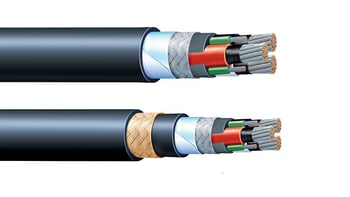Q1. Everyone agrees that the VFD is the cause of the common mode voltage that causes capacitive discharge current through the bearings, and the goal of shaft grounding is to create a safe path for current to flow back to the drive. With this in mind, if you use a proper VFD cable, would you bond the ring to the cable screen gland for the shortest path back to the drive, or would you still bond the motor to the surrounding structure?
A1. There are two separate ideas here: First, you are absolutely right that the point of shaft grounding is to give current a non-destructive path back to the bearings. That's why you should use proper VFD cable, as we have discussed recently. But bearing protection pales in comparison to life safety. The motor must be bonded to the facility ground for safety. If a fault occurred in the motor such that a winding shorted to the frame, the VFD cable might not be able to carry all of that current. So you need the motor grounded in the usual way.
Bonding a grounding ring directly to the mesh in a VFD cable is unnecessary. When the grounding ring is just bonded to the motor frame, current can move freely between the motor shaft and frame. From there, as you said, it wants to get back to the drive. There are at least two paths: Through the VFD cable directly back to the VFD, through the motor's ground connection, through the building's steel frame, and then back to the drive. Which path will the current take? All of them!
Electric current always splits and takes all available paths, in inverse proportion to their impedance (or resistance, for dc). The mesh inside a VFD cable is specifically designed to have low impedance to high-frequency current. Most likely, the return path through the cable will have lower inductance than any possible path through the building's ground system. So the lion's share of this current will go directly back to the drive through the cable, rather than wandering through the facility, interfering with other systems. This is why it's so important to use high-quality VFD cable.
Q2. I have heard that if the drive is closer than 20' (6m) to the motor, shaft grounding is not necessary. Is that true?
A2. VFD manufacturers say you should keep the drive within 100-150 feet (30-46m). At higher distances, you get reflected voltage waves. Voltage reflection can double the voltage level at the motor terminals. This idea is shown in the figure: The blue wave is voltage coming from the VFD, moving right, and the green wave is reflected voltage, moving left. The red wave is their sum: the total voltage at each point in the cable. (The voltage coming from a drive is a square wave, not a sine wave as shown here, but a square wave can be treated as a sum of many sine waves of different frequencies. We show only one frequency here for clarity.)_open.gif?width=350&name=640px-Standing_wave_SWR_4_(forward%2c_reflected)_open.gif)
Voltage reflection has two consequences. First, it can burn up the motor windings, and second, it makes for higher shaft voltage. Higher shaft voltage means you have more energy available to discharge through the bearings. So more damage per arc, and damage builds up faster.
So large distances are bad, but as far as bearing safety goes, shorter distances aren't necessarily safe. Under 100', you don't get voltage doubling, but the voltage doesn't change much whether you've got 90' or only one foot between the motor and drive. Even without voltage doubling, your average motor-drive system has plenty of shaft voltage available to damage the bearings.
If you ever see us at a tradeshow, we have demo motor tables with a 1 hp motor and a drive mounted right next to it. You can't fit your hand between the two. But as soon as you turn the system on, you can look at the shaft voltage on an oscilloscope and see discharge occurring.
AEGIS Shaft Grounding Rings come with a 2-year extended warranty against bearing fluting damage. No other form shaft grounding offers a warranty like this.
To learn more about AEGIS shaft grounding and best practices for electrical bearing protection, sign up for a training. We offer monthly live training webinars, and – pandemic restrictions permitting – we can also visit your facility to review your exact application.



